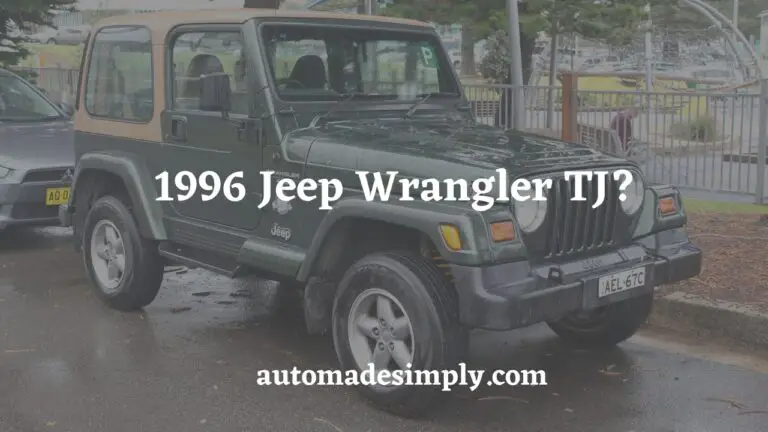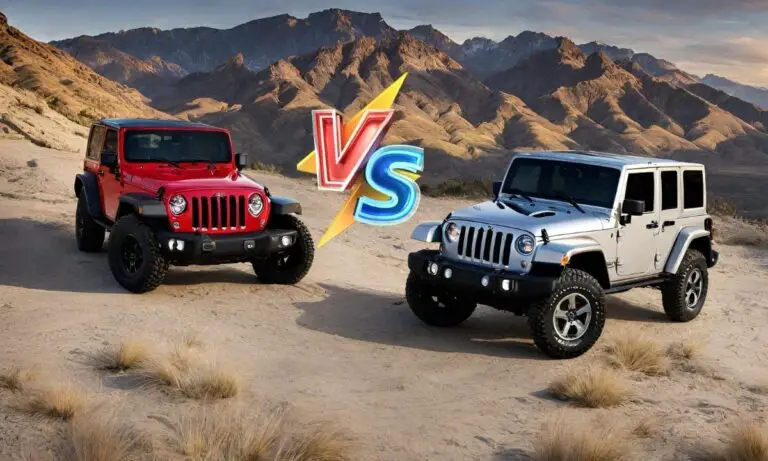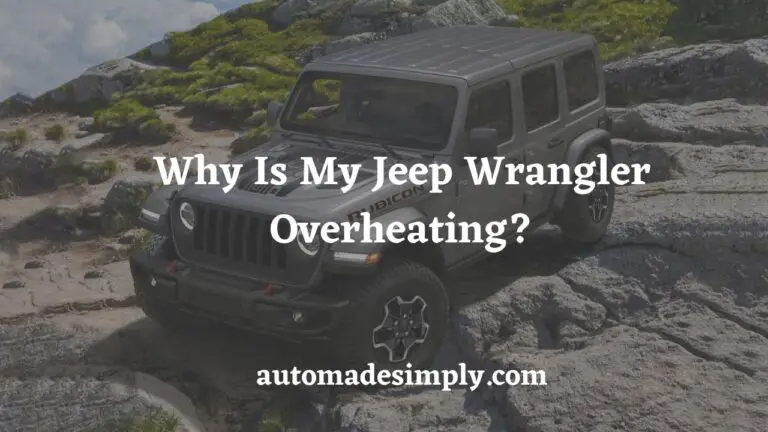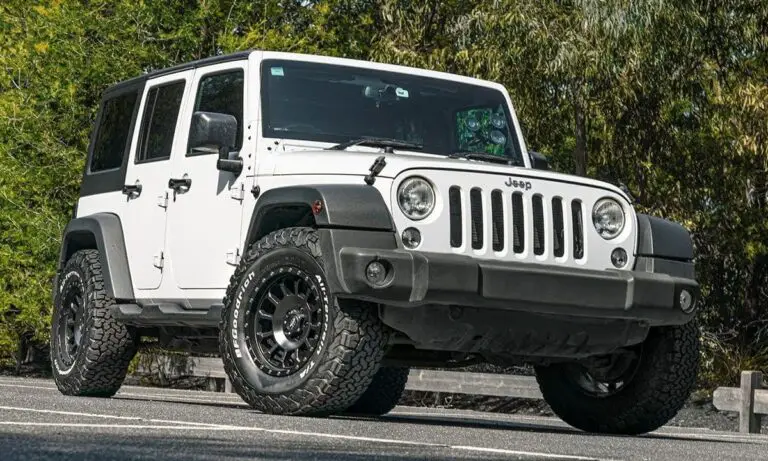Jeep Wrangler 4 Cylinder Vs 6 Cylinder: Which One to Choose

The Jeep Wrangler is an iconic off-road SUV known for its rugged capability and open-air fun. Under the hood, Wrangler buyers have a choice between two great engines: the turbocharged 2.0L 4-cylinder “Hurricane” engine or the naturally aspirated 3.6L V6 “Pentastar” engine. So which Wrangler engine is best – the 4 cylinder or 6 cylinder?
The 3.6L V6 is the best choice if you prioritize horsepower, torque, and towing capacity. The 2.0L 4-cylinder turbo gets better gas mileage while still providing responsive performance. Read on as we compare the Wrangler Hurricane and Pentastar engines in detail across horsepower, real-world MPG, tow ratings, driving experience, reliability, and more to help you choose the right Jeep Wrangler engine for your needs.
Table of Contents
Overview of the Jeep Wrangler 4-Cylinder and 6-Cylinder Engines
The 4-cylinder “Hurricane” engine debuted in 2018 when Jeep introduced the JL Wrangler generation. This 2.0L turbocharged 4-cylinder engine replaced the old 3.8L V6 as the base Wrangler engine, providing increased efficiency while making 270 horsepower and 295 lb-ft of torque.
Jeep’s venerable “Pentastar” 3.6L V6 engine continues as the optional upgrade engine for the Wrangler. First appearing in 2011, the V6 makes 285 horsepower and 260 lb-ft of torque in the Wrangler. This naturally aspirated 60-degree V6 provides plenty of low-end power for off-roading and towing.
Horsepower and Torque Comparison
When it comes to raw power specs, the V6 Wrangler edges out the 4-cylinder:
- Horsepower: 285 hp for the 3.6L V6 vs 270 hp for the 2.0L 4-cylinder
- Torque: 260 lb-ft for the V6 and 295 lb-ft for the turbo 4-cylinder
So while the V6 has a higher horsepower rating, the turbocharged 4-cylinder actually makes more peak torque. Torque is the twisting force that gives you acceleration, allowing the 4-cylinder Wrangler to feel peppy off the line.
However, looking at the broader torque curve shows an advantage for the V6. The Pentastar engine offers strong torque through most of the RPM range, while the 4-cylinder’s torque drops off sharply after peaking around 2000-3000 RPM. This gives the V6 superior real-world acceleration and passing power.
Multiple car reviews and acceleration tests show the V6 Wrangler reaching 60 mph about 1 second quicker than the 4-cylinder, taking around 6 seconds to get up to highway speeds. So for drivers who care about quick throttle response and power for merging, the V6 is the clear winner.
Fuel Economy and MPG Comparison
Fuel efficiency is one area where the 4-cylinder Wrangler shines compared to the thirstier V6. Here are the EPA estimates:
- 4-Cylinder: 22 mpg city / 24 mpg highway / 23 mpg combined (manual), 22 mpg city / 25 mpg highway / 23 mpg combined (automatic)
- 6-Cylinder: 17 mpg city / 23 mpg highway / 19 mpg combined (manual and automatic)
So the 4-cylinder with its turbocharging and lower displacement has a significant MPG advantage over the V6 in city driving and overall. This translates to real world results too, with 4-cylinder Wrangler owners reporting averages around 22-25 mpg, while most V6 models achieve 17-21 mpg.
Gearing and weight impact mileage too. The 4-cylinder can be paired with lower axle gears optimized for efficiency. And newer JL models shed weight from previous generations. Still, while the turbo-4 Wrangler promotes fuel savings, especially around town, the heavier V6 models sacrifice efficiency for power.
Towing and Payload Capacity
Towing and hauling capacity provides another win for the V6 Wrangler. Let’s look at the max ratings:
- 4-Cylinder Wrangler Towing: 2,000 lbs with manual transmission or 1,500 lbs with automatic
- 6-Cylinder Wrangler Towing: 3,500 lbs with manual or automatic
The V6 achieves significantly higher tow ratings of 3,500 pounds, able to pull small boats, ATVs, snowmobiles, and lightweight campers with ease. The 4-cylinder maxes out at just 2,000 lbs for the manual or 1,500 lbs when equipped with the automatic.
Payload capacity follows a similar pattern, with V6 models rated for 1,000-1,200 lbs and 4-cylinders at 900-1,000 lbs. So if you plan to haul heavier gear or need to pull a trailer, the V6 provides that crucial extra muscle. Just don’t expect to reach maximum ratings without proper equipment like a tow package and trailer brakes.
Reliability and Ownership Comparison
How do these two modern Jeep engines stack up long-term in terms of reliability and ownership costs? Overall, both the Hurricane 2.0L turbo 4-cylinder and the Pentastar 3.6L V6 are solid engines with few common issues reported when properly maintained.
The turbo-4 sees some typical problems like oil leaks, coolant leaks, and ticking noises. But no widespread defects have surfaced yet. The V6 does have two trouble spots to note – cylinder deactivation lifters can fail, causing a tapping sound, and the exhaust manifolds have cracking problems. But besides those flaws, the Pentastar is generally reliable.
Maintenance costs are close, with both engines requiring regular oil changes, fluid checks, and periodic timing belt replacement. Costs spike for major repairs down the line, with the V6’s greater complexity driving up prices for jobs like cylinder head or turbo replacements.
So while the factory warranties are similar, long-term the 4-cylinder engine may have slightly lower ownership costs. But stick to scheduled maintenance and both Wrangler powerplants can go 200,000+ trouble-free miles.
Driving Experience and Off-Road Performance
Beyond the specs, the different power delivery of these two engines creates a noticeably different driving experience behind the wheel. The turbo-4 offers more immediate low-end torque for acceleration off the line and out of corners. But it runs out of steam at higher rpm. The linear V6 pulls strongly through its whole power band, providing more responsive passing power.
For off-road crawling, the V6’s abundant low-end torque gives it an advantage in 4WD low range. The smooth delivery helps modulate throttle over obstacles. Turbo lag in the 4-cylinder can make slow-speed finesse more difficult. But both Jeep engines have ample grunt for the trails when geared properly.
The turbo-4’s lighter weight does benefit handling, allowing for flatter cornering and better braking performance. And some drivers prefer the 4-cylinder’s smaller packaging that improves front visibility compared to the bulky V6.
So while the V6 delivers a muscular feel, the 4-cylinder shouldn’t be dismissed as underpowered. The turbo torque pairs nicely with the new 8-speed automatic transmission and either engine provides a satisfying Wrangler experience on- and off-road.
Which Jeep Wrangler Engine is Right for You?
So given all the factors, which Wrangler engine is the best choice?
The 4-cylinder is ideal if gas mileage and commuting efficiency are your top priorities. The turbo-4 has significantly better city and combined MPG to save on fuel costs. And you still get responsive acceleration for around-town driving. Just watch out for turbo lag.
Go for the V6 if you need to tow boats, ATVs, trailers or haul heavy loads. The 3.6L Pentastar is clearly the winner when it comes to towing capacity, rated for up to 3,500 pounds. And the V6 offers greater payload capacity and more muscular performance for off-roading.
Consider the costs. The 4-cylinder will be cheaper to buy upfront. And while reliability is close, maintenance may cost less long-term as well. But evaluate fuel savings vs added premiums for the upgrades V6.
Think about your driving habits. The V6 may be worth it for drivers who value passing power and need to frequently merge and accelerate onto highways. But the 4-cylinder offers plenty of pep around town.
Whichever Wrangler engine you pick, you’ll get Jeep’s renowned fun, freedom, and adventure. Just be sure to take into account your budget, how you plan to use your Wrangler, and what level of power and capability you expect. Both the Hurricane 4-cylinder and Pentastar V6 are great engines, so you can’t go wrong building the ideal Wrangler for your needs!







